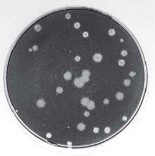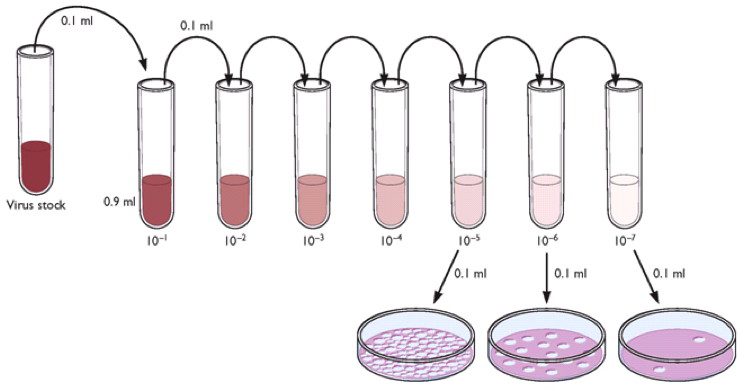One of the most important procedures in virology is measuring the virus titer – the concentration of viruses in a sample. A widely used approach for determining the quantity of infectious virus is the plaque assay. This technique was first developed to calculate the titers of bacteriophage stocks. Renato Dulbecco modified this procedure in 1952 for use in animal virology, and it has since been used for reliable determination of the titers of many different viruses.


The titer of a virus stock can be calculated in plaque-forming units (PFU) per milliliter. To determine the virus titer, the plaques are counted. To minimize error, only plates containing between 10 and 100 plaques are counted, depending on the size of the cell culture plate that is used. Statistical principles dictate that when 100 plaques are counted, the sample titer will vary by plus or minus 10%. Each dilution is plated in duplicate to enhance accuracy. In the example shown below, there are 17 plaques on the plate made from the 10-6 dilution. The titer of the virus stock is therefore 1.7 x 108 PFU/ml.


Next we’ll consider how the plaque assay can be used to prepare clonal virus stocks, a step that is essential for studying viral genetics.
Dulbecco, R., & Vogt, M. (1953). Some problems of animal virology as studied by the plaque technique. Cold Spring Harbor Symp. Quant. Biol., 18, 273-279

Pingback: The Plaque Assay | Citizen Science 2017
Dear Sir , we are facing problem with viral plaque assay that always our cell lines die after poring the mixture of agrose .. can i hear recoomendations from you ?
Dear all, I am performing a plaque assay and looking for a recipe for the agarose/agar medium that I can make myself. Due to time constraints it is not feasible to order pre-made in. Any suggestions welcome, thanks.
sir i am doing plaque assay for NDV on cef-df1 cell lines but the 2%agarose i use for overlay has a detrimental effect on my cell line and its dead overnight what can be done to prevent the same